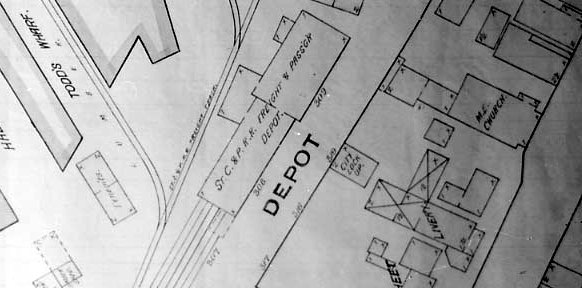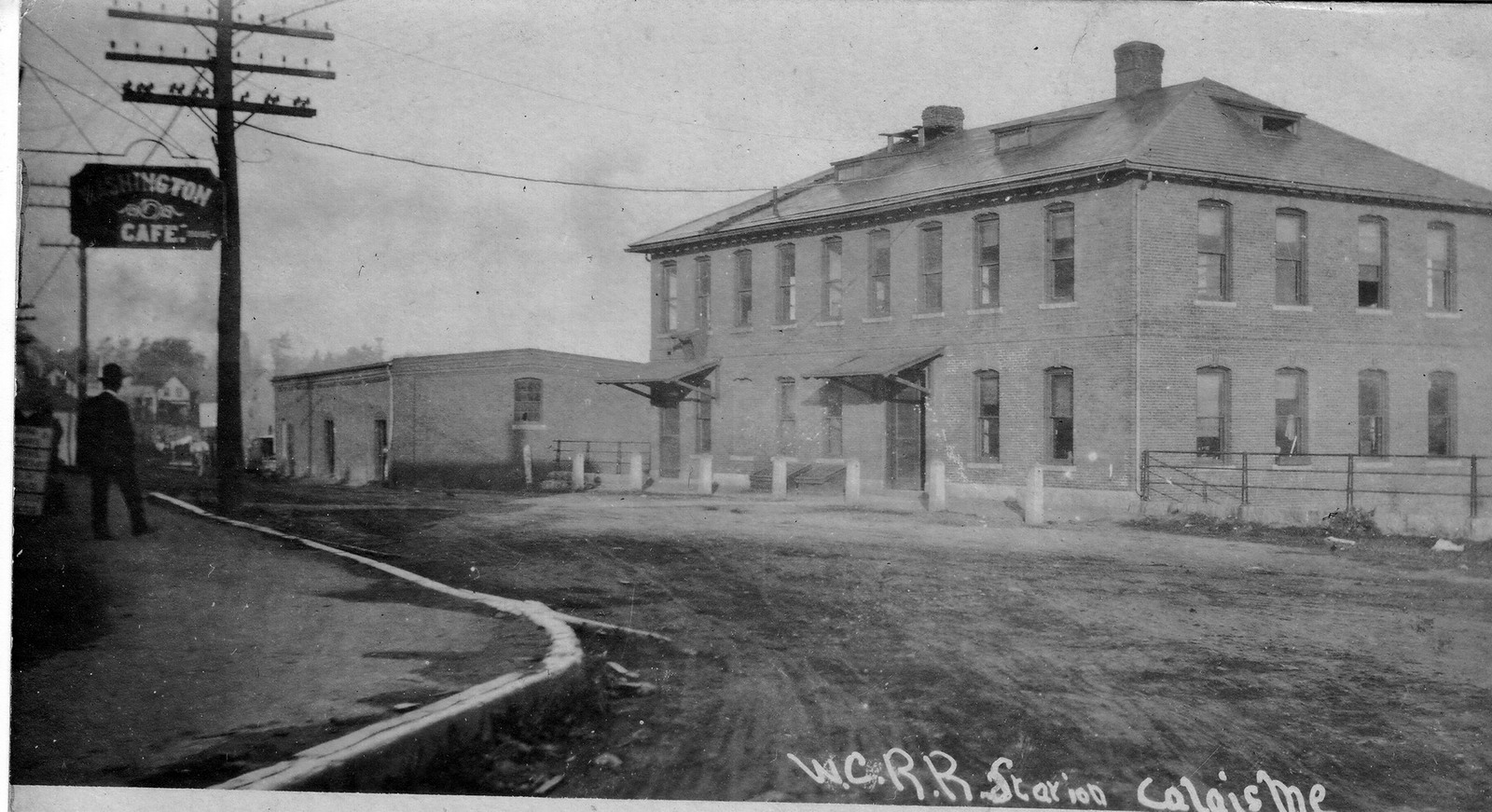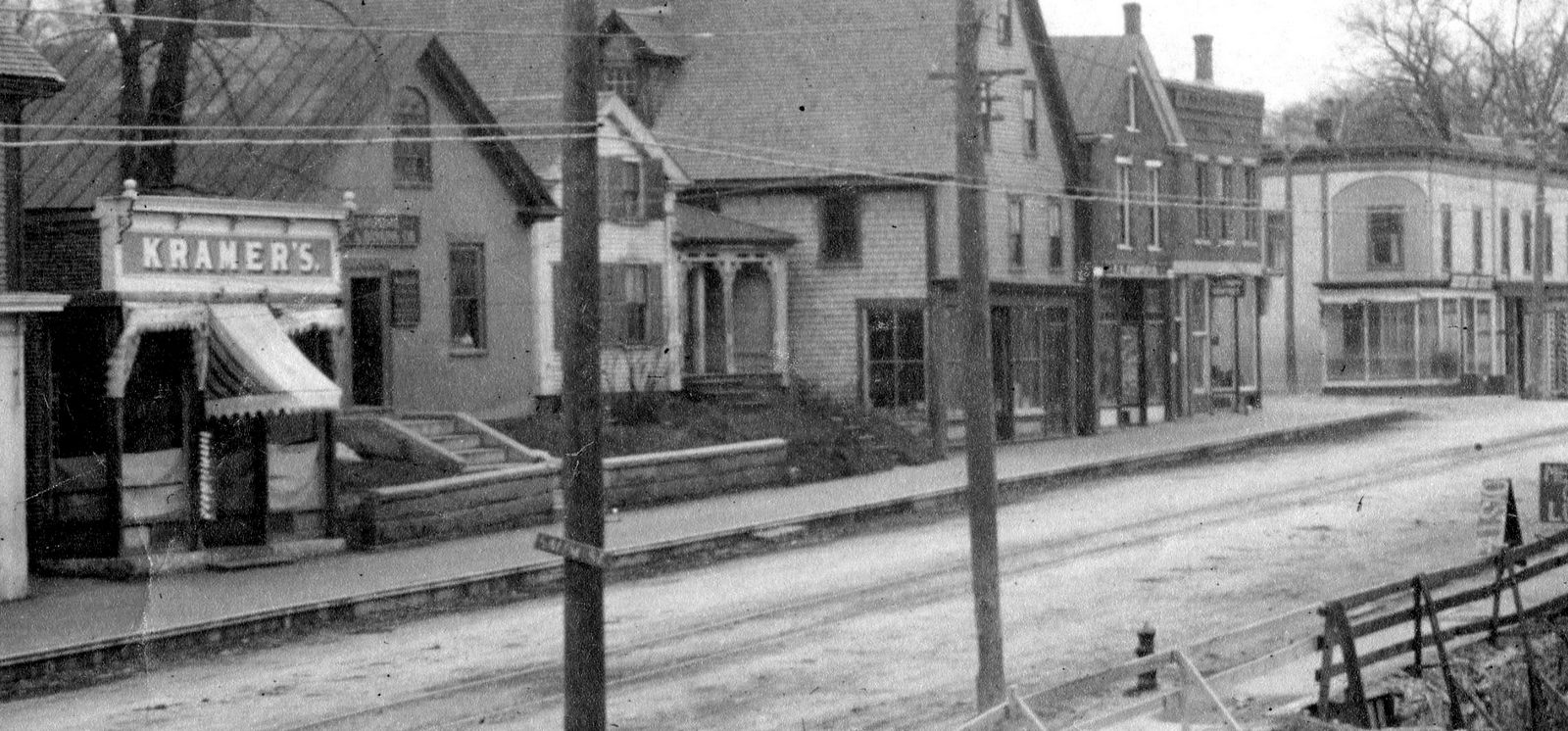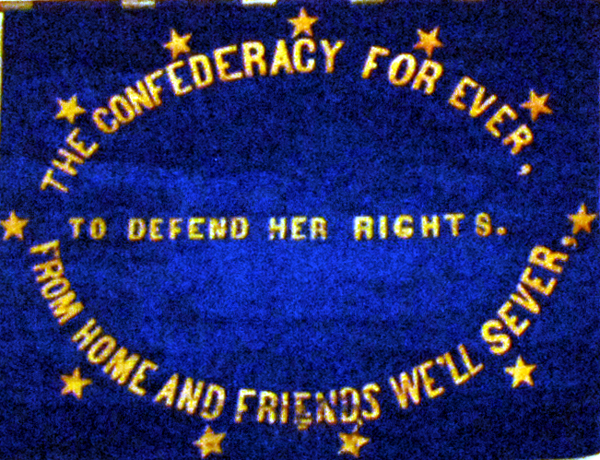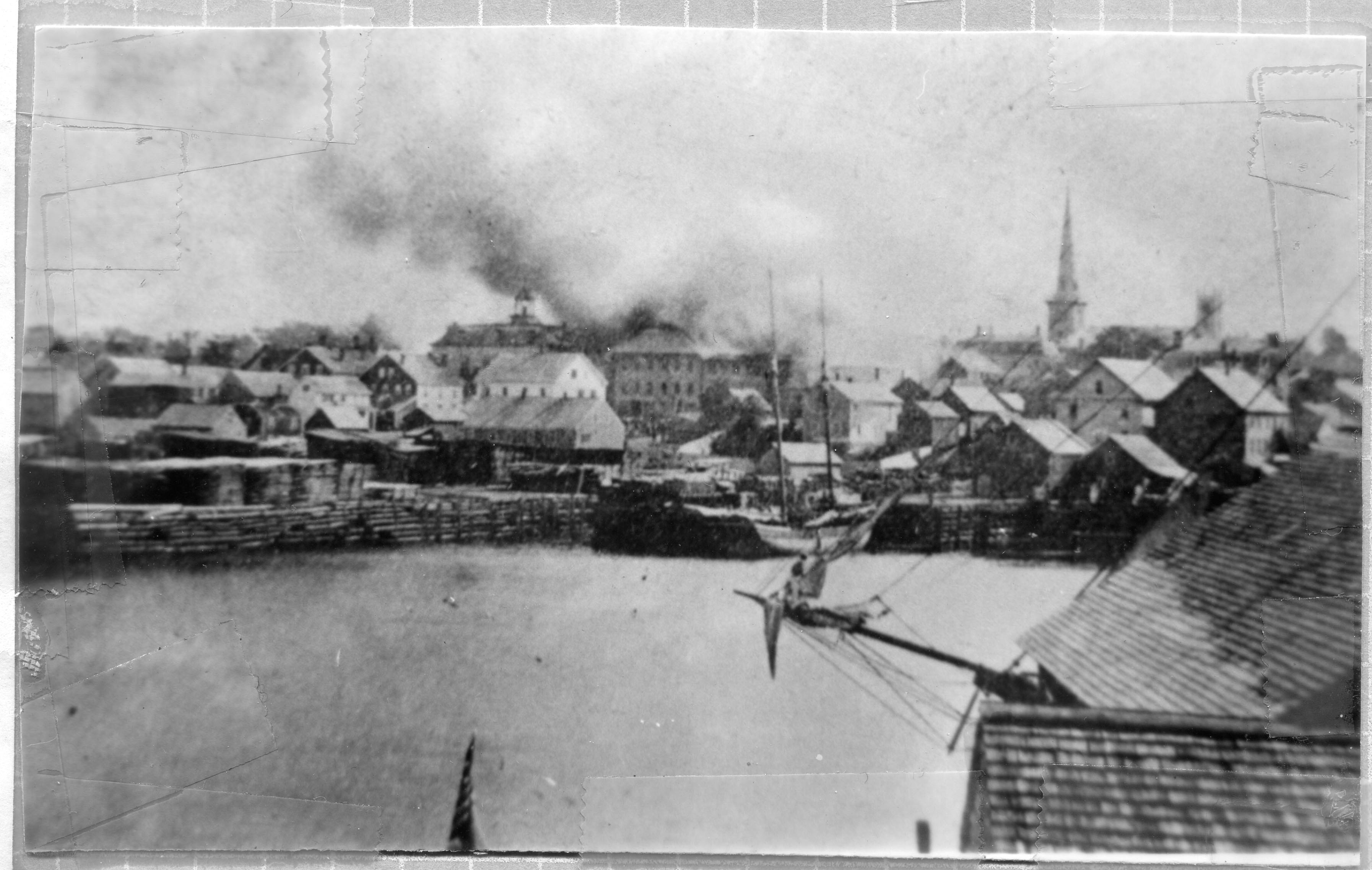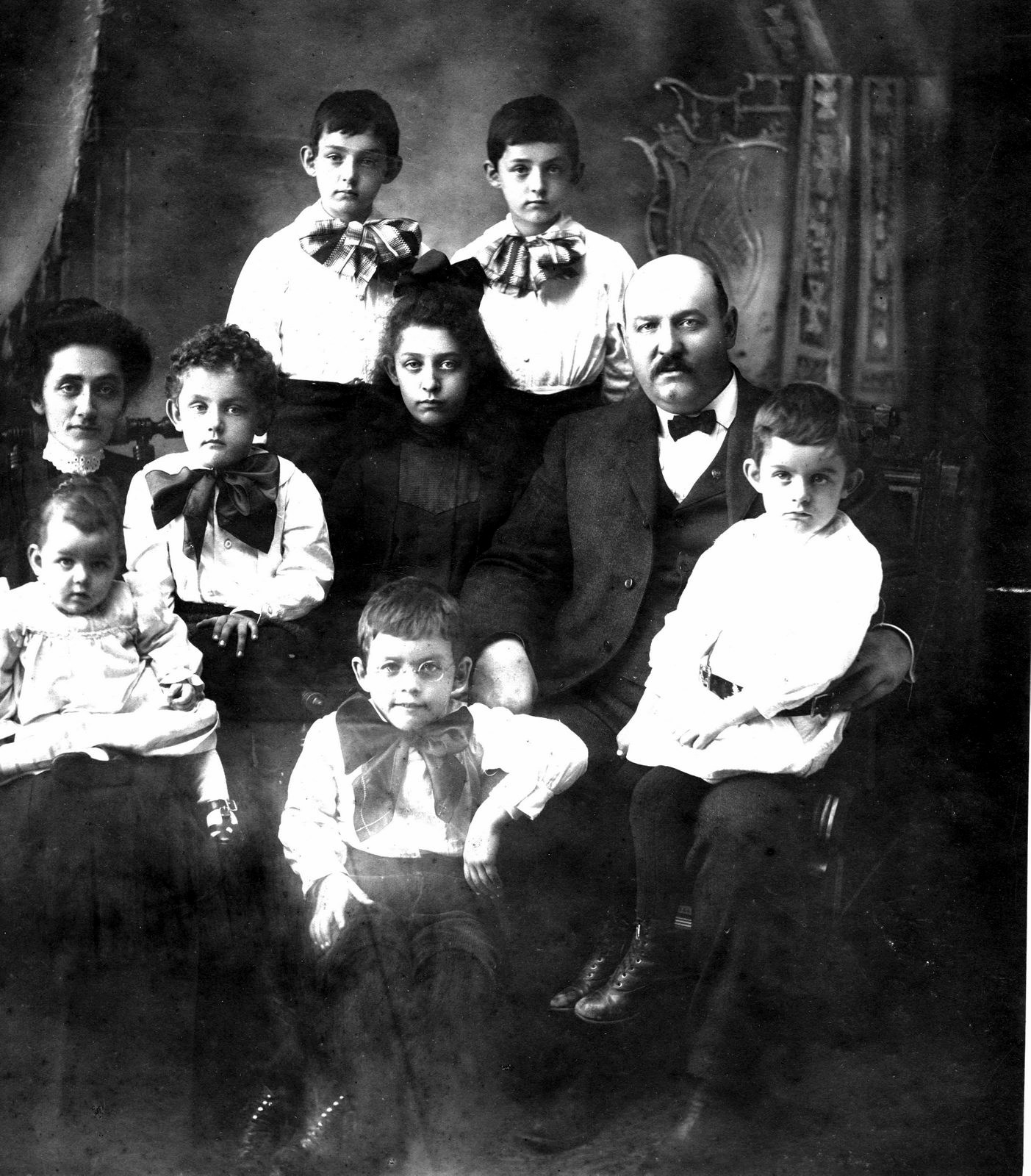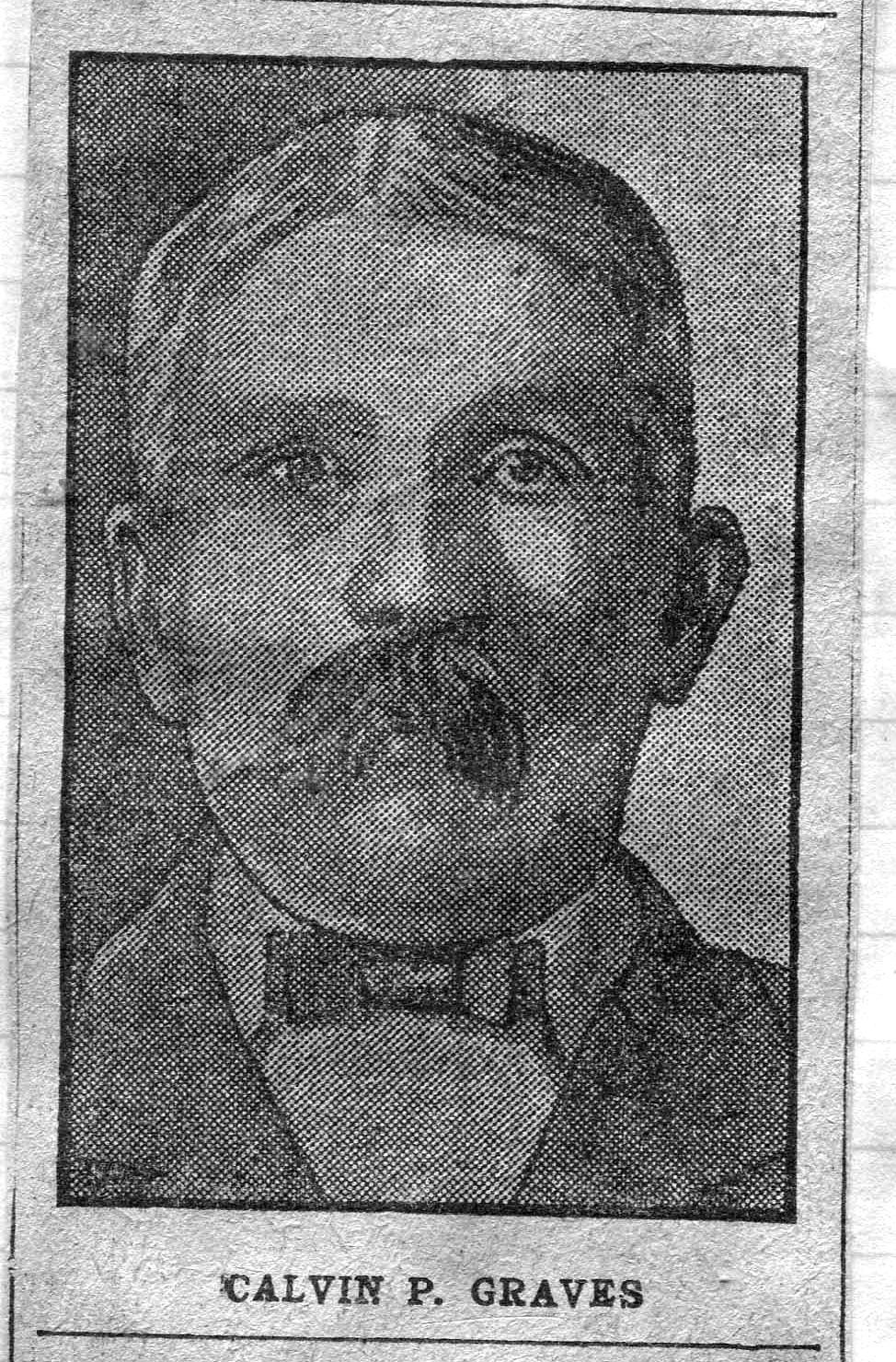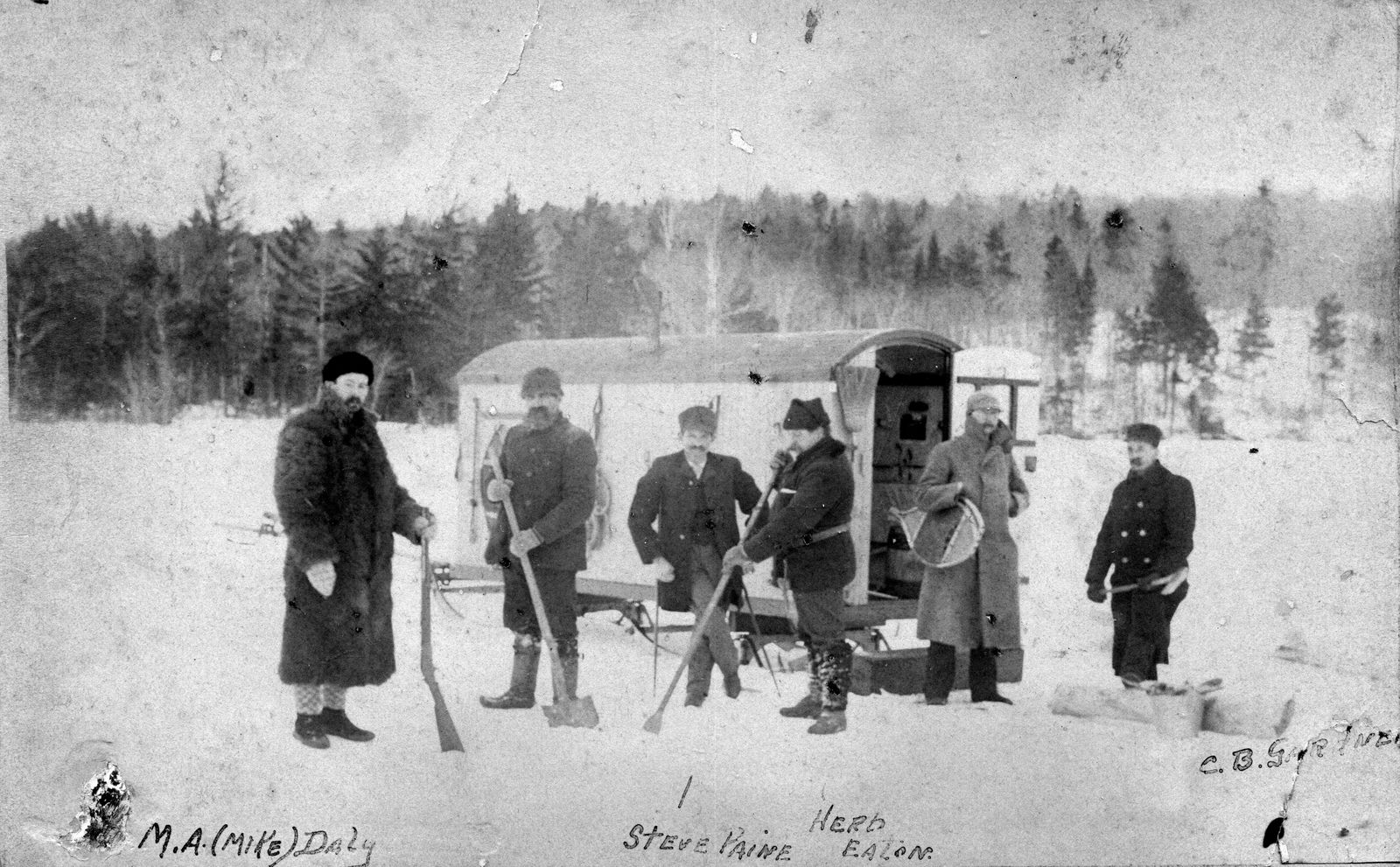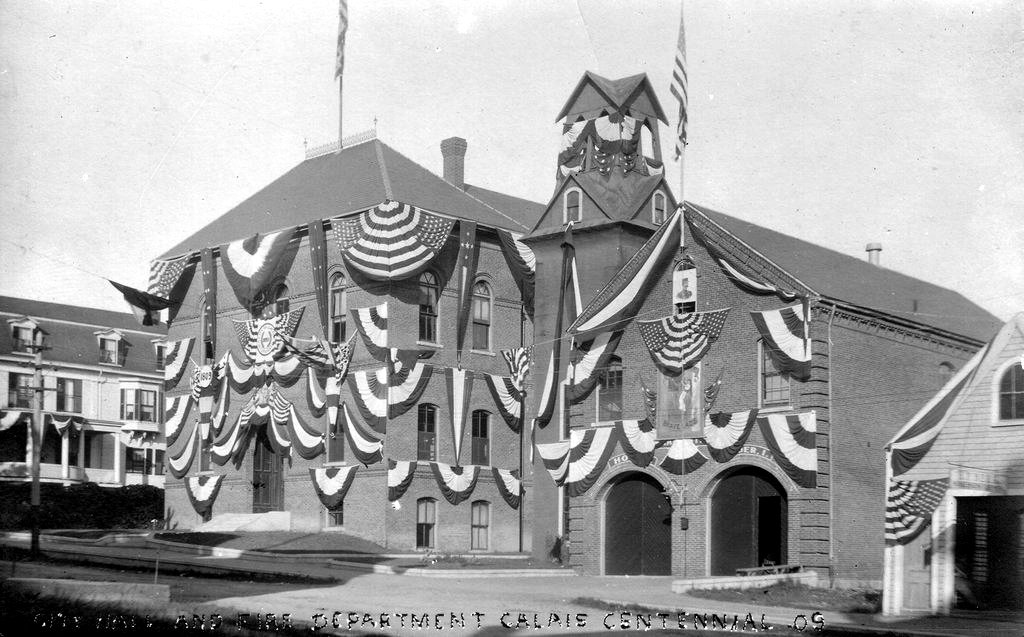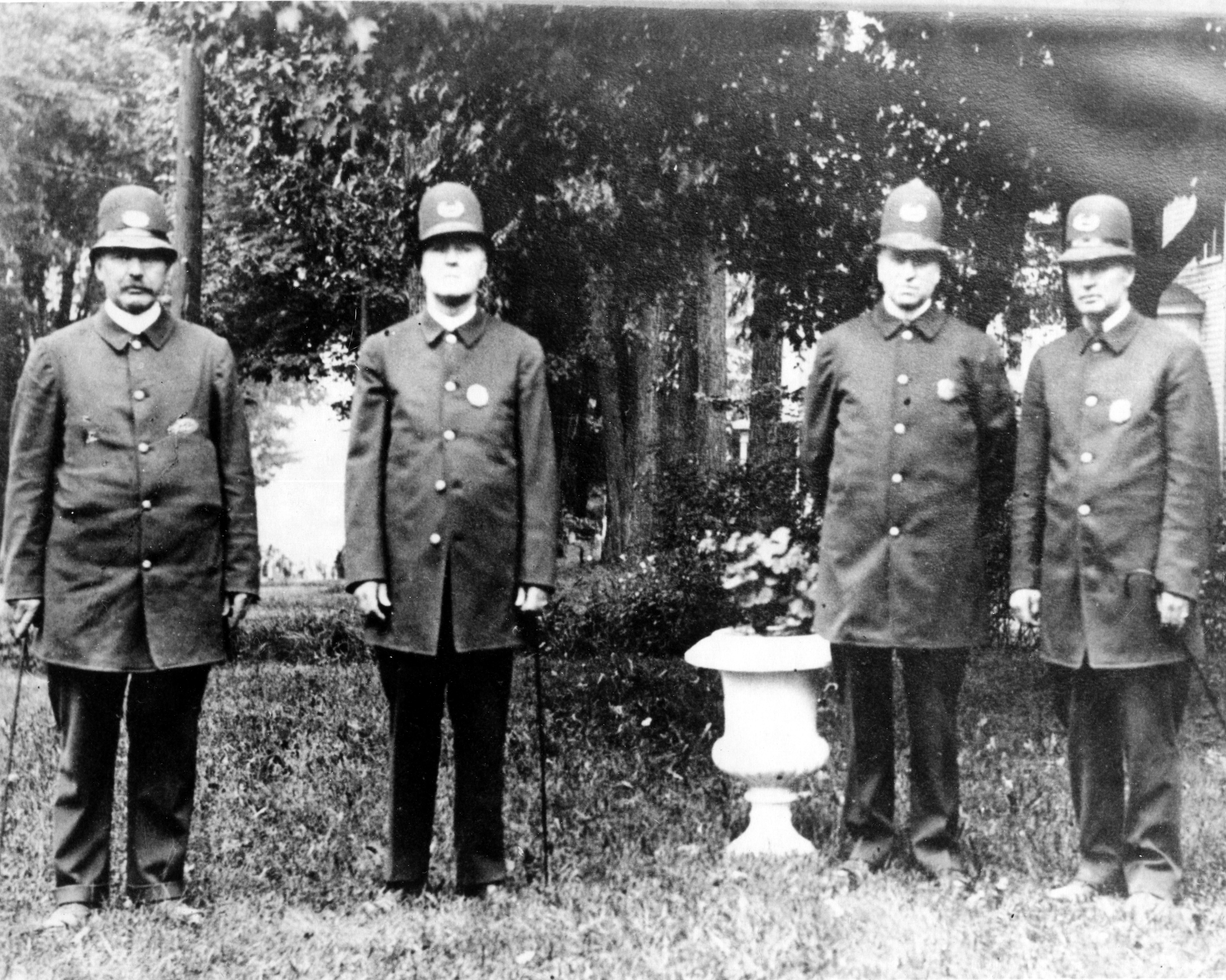Calais in the early 1800’s was a pretty rowdy town if the reports of drinking and brawling even during town meetings are any indication of the general behavior of some of the local citizens. This isn’t even taking into account the hundreds of sailors of every nationality who roamed the streets near the wharves in search of entertainment. There must have been “law” of some sort present to detain the serious troublemakers and a place to lock them up until demon rum lost its grip but early town records aren’t very helpful in locating the jail. We believe the answer is on the 1880’s map above which shows, just below the “T” in Depot, a “City Lock Up” on Depot Street, now Hog Alley. This is where the rear entrance to Johnson’s Hardware was located before it burned in 1996. Some of our Canadian members may recall picking up disassembled bikes at this rear door back in the 50’s and 60’s.
Note the Methodist Church (M.E. Church) on Main Street on the map above as there will be more later about the unfortunate minister of this church. He became an inmate of the lockup in a dispute over church suppers.
From the mid 1800’s the railroad depot was located on Hog Alley and the “lockup” would have been up the street from the Washington Café and across from freight building in the above late 1800’s photo. The building to the right is the former Heritage Center and the freight building next door is now apartments owned by Mike Johnson.
It’s very likely this lockup was the first City jail and served this purpose until the City Building on Church Street was constructed in 1903. The lockup held some fairly notorious criminals in its day. The first unfortunate guest we can identify was, according to the Frontier Journal of 1849, an itinerant preacher who is identified only as Wood. The Reverend Wood went in search of converts in Baileyville and found at least one, a young women from a respectable family who he married. Unfortunately the Reverend Wood was black and the bride was white. The uproar was furious, the Sheriff undertook to arrest Wood for violating the Maine miscegenation law and Wood in turn threatened “to shot anyone who undertook to lay hands upon him”. The couple fled to St. Stephen but were apprehended and illegally extradited to Calais. Wood was put in the lockup. Even the Journal conceded the illegality of the extradition but felt it justified as Wood, who the paper refers to as “Sambo” was, the paper claimed, a notorious villain with several other wives and possessed a “heart blacker than his skin”. This incident sadly reflects the racial attitudes of the time and the yellow journalism which exceeded in crudity and sensationalism even that of the present day. We don’t know what happened to Reverend Wood or his wife.
In 1864 the Calais lockup received its most infamous guest- William Collins Captain in the Confederate Army and Intelligence Services. On July 18, 1864 Collins and three other rebels attempted to rob the Calais Bank. In the 1908 photo above the bank, still in business, is to the right of the Kramer’s Clothing Store. The corner of Monroe Street and the Boston Shoe Store are to the far right. What is now considered a rather bizarre and insignificant incident during the Civil War was not so at the time. Collins plan was not only to rob the bank to provide funds for further Confederate depredations in the area but also to burn the city. 13 additional conspirators were to have arrived early that morning to take advantage of the chaos occasioned by the bank heist. They were to set fires throughout the downtown. Had the plan been carried out the wooden buildings along Main Street would have burned fiercely and much of the town would have been destroyed.
Thankfully for Calais Collins, while a brave and desperate character, had a penchant for bragging about his plans. Word was received of the plan in Calais the day before the robbery and the teller and customers in the bank when Collins arrived were all armed law enforcement officers. Collins and his gang were captured and taken to the Calais lockup. The only shot fired was discharged accidentally by an officer who shot himself in the foot. When arrested Collins had the above Confederate flag in his pocket. He intended to raise it over the smoldering remains of the City of Calais. Instead he was sent to State Prison from which he promptly escaped and rejoined the war effort. The second group of raiders apparently got lost or. as likely, got cold feet and never arrived. Collins remarked when arrested that had they not failed him things would have turned out differently and he’s probably right.
After the Great Fire of 1870 destroyed much of Calais including City Hall the City Council held meetings in the lockup which many citizens thought quite appropriate. The above photo shows the fire soon after it started in back of J.G. Beckett’s store, then located on the site of what is now the Schooner Restaurant.
Speaking of JG Beckett, the patriarch of the Calais Beckett family, we show him above in 1877 with the family. Frank, the famous candy maker, is one of the boys in the back. JG had quite a reputation for carousing. According to family legend, he was a notorious boozer who spent many a night with his low friends haunting the Calais bars. On one occasion the police escorted his drinking buddies to the lockup to cool off and JG, lonely for their company, engineered a successful jailbreak in order to continue the weekend revelries. Escapes from the Calais lockup were common. We are not sure how they managed to hold a desperado like Confederate Captain Collins. In 1894 the first bicycle theft occurred in the county. The Eastport thief rode his “wheel” all the way to Calais before being apprehended and jailed. He was convicted at a trial in the municipal court but before sentencing he escaped and was never caught. This was a common refrain in those days, the Calais lockup was very insecure and almost any determined miscreant could break out. Our cousins from across the river had great success in shortening their sentence by simply leaving early, often with the connivance of their jailers. Much to the consternation of the municipal law judge the City had little interest in incurring the expense of the feeding a Canadian cousin for 30 days for some venial infraction.
1894, the year of the first bicycle heist, also saw the arrest of the Right Reverend Fuller of the Methodist Church shown above. Most will not recognize this church but it was on Main Street directly across from the bottom of Monroe Street, where Sherwin Williams was located in the 1970’s:
According to Roy Wilson, a Calais historian:
The old Methodist Church was located on Main Street where the Johnson store is now or a little between the former Grant store and Johnson’s. At the time I have reference to, the church had a minister by name of Rev. Fuller.
I remember him well. He was a large man six feet or so tall. After he had been here for a short time he tried to have the officials of the Church abandon the Church suppers. His contention was especially if the women of the families didn’t have to devote their time to preparing the suppers, they would have time for other duties, which he felt was neglected. Also if the family tithed as they should, the church would not need the financial support of the public suppers. The decision was made a trial issue for a period of some months. But in a month or so it was decided by a number that on the premises of sociability they had to have the Church suppers. So, the next month the women and some of the men of the families went along with it. Now the minister argued that they were better off financially and why not leave it alone. But no, they had to have the social side. The night of the planned supper came and here is where the old “lock-up” on Hog Alley comes in.
The minister, the night of the supper, went down to the Church vestry where the suppers were held, still in protest, the committee decided he was obstructing the progress of the supper by his appealing to the public not to attend. So they sent down street for the then Marshall Charles Miller. He came up to see what the trouble was and they said they wanted him to arrest the minister. He refused, and returned home. Now what did they do? At that time we had seven (7) wards in the city with ward constables and in ward three (3) Tom McCullough Sr., not young Tom, was constable also a member of the Trustees of the Church, which was named Knight Memorial Church. So someone of the committee asked him to arrest the minister and he did so. He put him in the “lock-up” on Hog Alley. Now when the Marshall Charles Miller, heard of it he went down and told Mr. Fuller he couldn’t stay in his lock-up. The minister wanted to stay but the Marshall wouldn’t let him. Now I must say this split the church down the middle and it never was the same in my time.
The Calais Advertiser was outraged by the treatment of Rev Fuller. February 7, 1894:
“ There occurred this morning the most dastardly and disgraceful affair that ever happened in our city. We have had murders, kidnappings, riots and drunken brawls, but nothing but nothing more disgraceful than this morning transaction. The pastor of the Methodist Church, regularly assigned to this society, was forcibly taken by some trustees and placed in the lockup for conscientiously doing what he believed to be his duty. If this the kind of Christianity the Trustees of the church are imbued with, we should say, the sooner they are dropped from its rolls the better for its interests.”
Not long after the reverend’s release the Calais lockup had another star inmate, a desperate character by the name of Calvin Graves. His story is too long and oft told to go into much detail but Graves shot two wardens in Wesley when they threatened to shoot his deer chasing dog. Graves disappeared after the murders and fled to Anaheim California where he might have lived a free man had he not chosen to correspond with some unreliable relatives back home. Captured and extradited for trial Graves was the last man to be tried under the hanging law in the State of Maine although he received only a life sentence. He was held in the Calais lockup until they took him to Thomaston to serve his sentence. Graves was subsequently pardoned and released.
We mention one person who, in 1883, should have been an inmate of the lockup but was not because he was an Eaton, one of the wealthy and influential Eaton lumber family. Shown above ice fishing with friends after the shooting Herbert Eaton had shot and killed his friend Samuel Kelley after a drunken argument at the Eaton office building on Main Street in Calais. Eaton also shot his brother Joseph. Eaton was not arrested at the scene and later when murder charges were filed he was given plenty of opportunity to escape to Canada where deals were done and he returned to pay a $1000 fine. One person did do a stretch in the Calais lockup as a result of the murder- a Passamaquoddy hostler employed by the Eatons was held in the lockup as a material witness.
In 1903 the Calais City Building was constructed. The basement served as a police station and also contained two cells, one for each sex. Each cell had an iron bunk secured to the floor and a barred basement window that looked out at ground level onto the alley way between the City Building and the Fire Station. This alley went connected Church Street with Sawyer Avenue in back of the City Building.
One important inmate of the new jail was Clarence Beckett, the Mayor of Calais. Of course this was before he became Mayor: From his recollections of growing up in Calais:
Glenn Boardman and John Goode were pals and a little older than Bill Goode and me, who worked together. One day we iced up snowballs, hid behind a pile of four foot wood and surprised them. A few days later they caught me alone and marched me over to the Boardman Barn. They tied my hands and feet and put me in the manger from which the cow was feeding. They sprinkled grain on my face and head and I still remember that long tough tongue licking it off. Next they took me outside where there was a block and tackle to lift hay to the loft. They made a loop in the rope and lifted me to the top of the barn and left me there while they went to the movies. It was about an hour before a fellow came down the street and let me down.
Up to this point in my life there was only one incident that was more of a shock. When Bill Goode and I were seven or eight years old we batted ball in Bills side yard and broke a window. Bill’s father was Chief of Police and he told us that if we did it again he would put us in jail. Shortly after that we broke another window. After dinner he took us, one on each side, and marched us down the Main Street to the City jail where he locked us up. He kept us there until supper time. Lesson learned, I always wanted to keep away from jails. The police officers at that time were Martin Goode, Bill McNamara, Steve Greenlaw, Howard Eye, and in Milltown, Steve Woodman and Fred McKnight.
The photo above shows Luther Barnes behind the City Building at the Sawyer Avenue with Calais’ first police cruiser. Before the City bought the cruiser the police had to walk or in an extreme emergency take a cab.The jail cells are just to his left. The inmates of the cells could stand on the bunk or a chair and look out the barred window into the alley. Chatting with passers-by was a common diversion for the inmates. According to Ron O’Neill:
“In the 1930’s, on good Saturday nights a favorite activity for Calais kids was to head up to the old jail in the basement of the city building and talk to the inmates. We wanted to see who was there, get to talk with them. We did this most Saturday nights. It was something to do. We’d go and talk to them through the window. They were half drunk and harmless. I can’t remember any names specifically but we wanted to check who was there. Back then the Chief of Police couldn’t drive a car. His name was Bobby Carr ( Kerr) and I think he lived on the corner of Union and Pleasant Street. He’d take a taxi wherever he need to go. Taxis were very inexpensive then.”
In the early 50’s your writer often talked to the inmates through the same window. I was very young, perhaps not yet in school. I lived with my parents on Spring Street but as they both worked I spent most days with grandmother on Whitney Street down by the bridge. In those days parents were not unreasonably concerned about the safety of their children and mine allowed me to walk the mile home from Whitney Street to Spring Street each afternoon. My mother walked with me a few times so I’d know the route and, without my knowledge, followed me for my first couples of trips but then I was left on my own. This meant, of course, exploring and taking shortcuts. One of these shortcuts brought me through the alley between the City Building and Fire Station and by those basement windows to the cells in the jail. When there was someone looking out the window I stopped and talked. The prisoners were very friendly. They would ask me where I had been that day and what I had done because, of course, they were bored and found even a conversion with a child diverting. One day an inmate gave me a candy bar which I took home. When my mother questioned me about it and I told her about my new friends at the jail. She told me not to take this shortcut again but I confess I disobeyed her and continued to go through the alley hoping someone would be peering through the bars but I always ate the candy bar before I got home.

